my collection
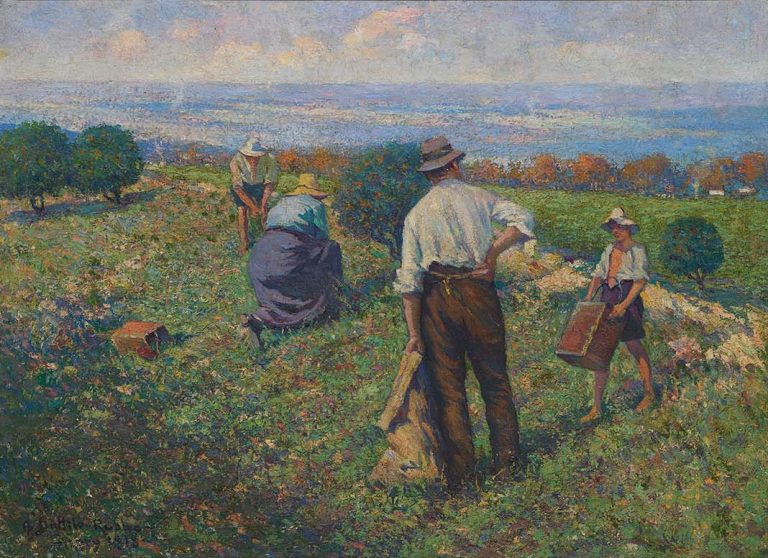
Anthony Dattilo RubboPea gathering (Kurrajong Heights) 1918
Artwork
‘As an artist, Dattilo-Rubbo is best known for his social realist portraits of Sydney’s unconventional characters.’ 1 These portraits tackled new ground, as they depicted vagrants and old people, who were not typical subjects at the time. The works strengthened the early years of his career as they were highly admired for their craftsmanship and the genre resonated strongly with the Australian public.
In 1906, Dattilo-Rubbo travelled across various cities in Europe, which ignited his passion for modern art. Pea gathering (Kurrajong Heights) exemplifies Anthony Dattilo Rubbo’s style after 1906. It depicts Kurrajong Heights, north-west of Sydney at the foothills of the Blue Mountains — an area of scenic fruit orchards that was a popular destination for country holidays.
Endnotes:
1. Art Gallery of New South Wales, ‘Anthony Dattilo-Rubbo’, <https://www.artgallery.nsw.gov.au/exhibitions/antonio-dattilo-rubbo/>, accessed August 2020.
Artist
Anthony Dattilo Rubbo was born in Naples in 1870 and received classical art training in Italy. He arrived in Australia in 1897 having been awarded the diploma of professor of drawing in public institutions by the Royal Academy of Fine Arts, Naples, and began teaching in Sydney.
In 1906 Rubbo spent seven months in Europe. He returned with reproductions of paintings by Paul Cézanne, Paul Gauguin and others whose work was little known in Australia at the time. Influenced by these artists, Rubbo enthusiastically began to teach their ideas in his lessons at the Royal Art Society of New South Wales in Sydney. His students included Grace Cossington Smith, Roland Wakelin and Roy de Maistre.
Discussion Questions
1. The artist is capturing a moment in time where people are at work. What do you notice about the way people are working? What differences may we see if this farm scene was painted today?
2. Read the title of the artwork to determine which year the painting was made. Investigate and discuss what everyday life was like in Australia at this time.
Activities
1. Imagine what items could be inside the sack the man in the painting is holding. Use words to describe the shape, colour and purpose of the item, without revealing the object’s name. See if your friend can correctly identify this item.
2. Create a mixed-media farm scene with different coloured and textured paper (old magazines are suitable), collage materials, paints, glue and a piece of paper. You may like to use a sponge with paint to texturize the sky and then define the land at the horizon point with a different colour. When dry, add detail to the background. Tear pieces of paper to create shapes and include objects of different textures to add visual interest to your picture.
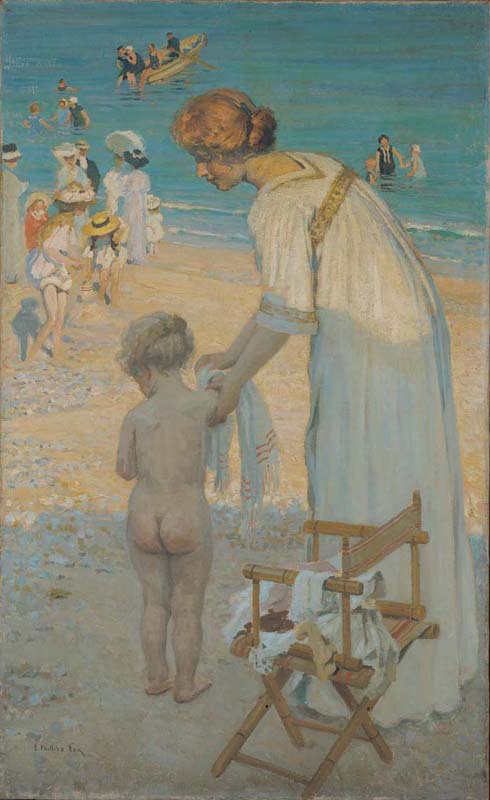
E Phillips Fox / Australia/France 1865–1915 / Bathing hour (L’heure du bain) c.1909 / Oil on canvas / 183.5 x 113.3cm / Purchased 1946 / Collection: Queensland Art Gallery | Gallery of Modern Art
E Phillips FoxBathing hour (L’heure du bain) c.1909
Artwork
Bathing hour (L’heure du bain) c.1909 is thought to depict a beach on France’s Channel Coast, which, in the early twentieth century, was frequented by the upper middle class.
Bathing was not yet common and, while it was unusual for a female child to appear naked in polite society, it was equally unusual for her to be tended to by her mother rather than a nanny. By contrasting the girl’s nakedness and the mother’s flowing robes with the more restrictive costumes of the women in the background, Fox may be commenting on the relaxation of social customs that was occurring in Europe at the time.
The painting is one of two versions of the same subject. The earlier of the two, entitled The bathing hour 1909, is in the collection of the Castlemaine Art Gallery & Historical Museum, Victoria. The immediacy of the brushwork and the realistic shadows that characterise the earlier version indicate that it was probably painted en plein air, directly from the subject. This later version, a more formal painting, in which the artist has eliminated some of the shadowing of the subject, was probably painted entirely in the artist’s studio.
Artist
Emanuel Phillips Fox was born in Fitzroy, Melbourne. He trained at the National Gallery of Victoria Art School from 1881 to 1886 and travelled to Paris the following year to study. Over the next five years, he joined artist colonies in northern France and in Cornwall, England, and exhibited in Paris.
On his return to Australia in 1892, his achievements were recognised with a solo exhibition of his work at the National Gallery of Victoria. In 1893 he and George Tucker established the Melbourne Art School.
In 1902, Fox returned to Europe to paint Landing of Captain Cook at Botany Bay 1770, a work commissioned by the trustees of the National Gallery of Victoria. He married English artist Ethel Carrick in 1905, and the couple based themselves in Paris while Fox made a series of painting trips through France, Italy and Spain. They returned to Australia in 1913 where Fox undertook a series of portrait commissions of eminent Australians.
Discussion Questions
1. In this painting Fox has portrayed a mother and daughter at the beach in France. What are some similarities between this scene from a long time ago and a scene at one of Australia’s local beaches today? What are some of the differences?
2. The shadowing in this painting is a visual device. Can you explain its purpose?
Activities
1. Create a series of drawings or paintings that show the types of activities you would do on holiday or on the weekends. Display the images with accompanying labels. Each label should include a title, date, artist and brief description.
2. Fox has created the sense of a warm summer’s afternoon by exploiting the complementary colour scheme of blue and orange. The warm tones of the sand and the mother’s hair contrast with the cool green-blue sea. Explore the shadows and light of an Australian beach scene by taking your own photos. Use your own complementary colour scheme (refer to a colour wheel) to develop your photographic studies into a painting. Mix the complementary colours together to create the shadows.
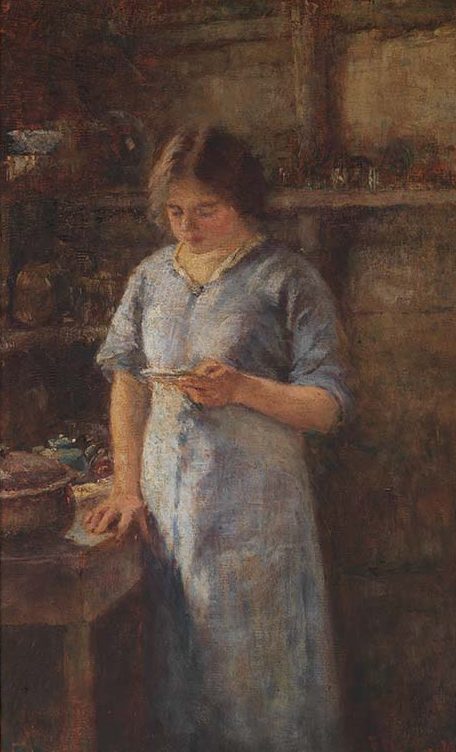
Frederick McCubbin / Australia 1855–1917 / The recipe 1914 / Oil on canvas / 66.2 x 41cm / Purchased 1951 / Collection: Queensland Art Gallery | Gallery of Modern Art
Frederick McCubbinThe recipe 1914
Artwork
The recipe depicts Frederick McCubbin’s second youngest daughter, Sheila, reading a recipe card in the pantry of Fontainbleu, the family’s home at Mt Macedon in Victoria. 1 According to McCubbin’s youngest daughter Kathleen, the work would have been painted during the family’s summer vacation. 2
‘The painting is not a portrait of Sheila, but a portrayal of the domestic interior she inhabits, her own private universe. The theme was the mainspring of Edwardian painting, which McCubbin knew from London. It is McCubbin’s choice of subject that reveals the influence of his 1907 trip there, as well as his brushwork, feathery in parts, burnished in others.’ 3
Endnotes:
Artist
Frederick McCubbin was born in Melbourne in 1855, the son of a baker who had recently emigrated to Australia from England.
When he left school in 1869 at the age of fourteen McCubbin began work in a solicitor’s office, his father hoping that he would make law his career. McCubbin however spent most of his time making model theatres until his father found out and sent him to work at the family bakery.
The next year McCubbin began studying drawing at night at the Artisans’ School of Design at Carlton, where his teacher was Thomas Clark. When Clark became drawing master at the Melbourne National Gallery School, McCubbin enrolled there.
Recognizing his son’s determination to become an artist, McCubbin senior apprenticed him to a coach-maker where he learnt to paint emblematic and decorative designs. This apprenticeship ended in 1875 and McCubbin enrolled fulltime at the Gallery School, studying painting under Eugen von Guerard. McCubbin found von Guerard’s teaching uninspiring as he expected students only to copy pictures in the Gallery’s collection.
On the death of his father in 1876, McCubbin had to leave his studies to work in the family business. He continued to study painting at night at the Gallery School where he formed a friendship with fellow student, Tom Roberts.
Discussion Questions
The recipe captures a leisure moment where Sheila is preparing to cook something from a recipe. Compare this painting with others in ‘Roy and Matilda: The Mysterious Music’ to discuss everyday activities from the past.
Do people still participate in these activities today? Discuss your ideas.
Activities
Do you have a favourite family recipe or food that you enjoy cooking or eating? Make a list of each person’s favourite dish and see how many differences or similarities there are. Which one is the most popular? Investigate some common dishes or recipes from the era of this painting.
Assemble four or five objects from a recipe and place these in a bowl or on a flat surface. Create a still life drawing or painting that captures these objects. Alternatively, take a photo of the still life assemblage and use different effects to alter the look of the image.
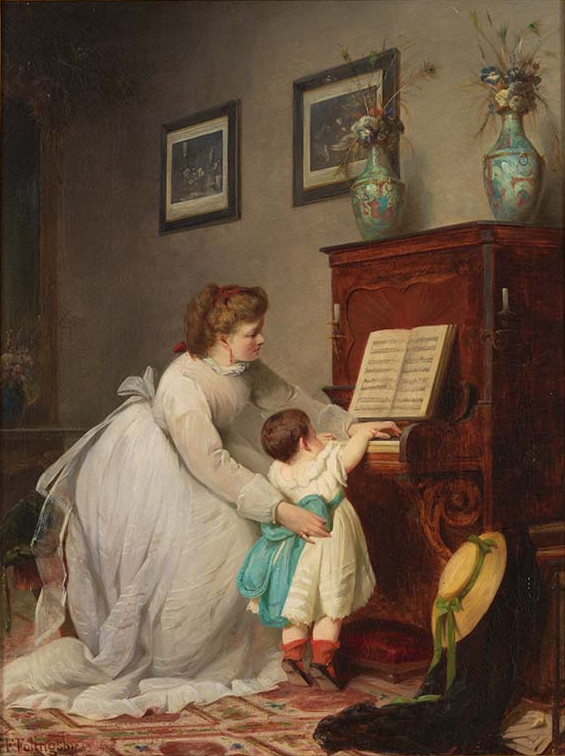
G.F. Folingsby / Germany/Australia 1828—91 / The first lesson 1869 / Oil on canvas / 83.5 x 63.8cm / Purchased 1990 / Collection: Queensland Art Gallery | Gallery of Modern Art
G.F. FolingsbyThe first lesson 1869
Artwork
George Frederick Folingsby’s special skill in painting drapery and costume led to many works featuring full length fashionably costumed women. In The first lesson the elements of patterned rug, cloisonné vases, prints on the wall, and hat and cloak casually positioned to one side act as forms and shapes as well as devices for counterpointing colour notes in the figure studies.
The conventional pyramid structure in the figure composition uses the gaze of the woman at its apex to draw the viewer to the narrative. Her half-seated position allows the artist to explore the texture, trimming and fullness of her gown. The pale grey of her sash is played off in the darker grey of the prints, the grey-green of her hat ribbon and a dramatic reprise is developed with the bright blue-grey of the child’s sash. The use of red is developed in a similar way and extended to major furnishings in the pattern in the rug and in the warm mahogany tone of the timber in the piano.
This painting shows the artist’s wife, Clara, and his daughter. Clara Folingsby was herself an artist who was committed to an insane asylum in Heidelberg, Germany. A few years after her death in 1874, Folingsby migrated to Australia with his daughter.1
Endnotes:
1. This information was obtained from the Folingsby family.
Artist
George Frederick Folingsby arrived at Melbourne, Australia, in July 1879 and established a reputation as a portrait painter. From 1882 he was master of Melbourne’s National Gallery Art School. His teaching was a major influence on Australian painting and it formed the basis for several important figure paintings with Nationalist overtones. He also encouraged the combination of figures and landscape.
Several of Folingsby’s works show interior incidents of confrontation or dramatic discovery with the action arranged laterally or diagonally across the space. It is a conventional compositional device adopted by many of his students.
Discussion Questions
1. Take a minute to slowly look at this painting. What did you notice first? Has the artist used a particular method or technique to draw your eye to this section of the painting? Explain your thoughts.
2. Can you identify any items in the picture that may provide a clue that this painting was made a long time ago?
Activities
The artist has painted some objects with decorative patterns and shapes to include in his artwork (clue: look at the floor rug). Be inspired by a couple of different shapes or motifs you can find in the painting to create your own unique design.
Repeat the shape or motif on A4 paper to create a pattern. Using pencils or crayons, add colour to your decorative design.
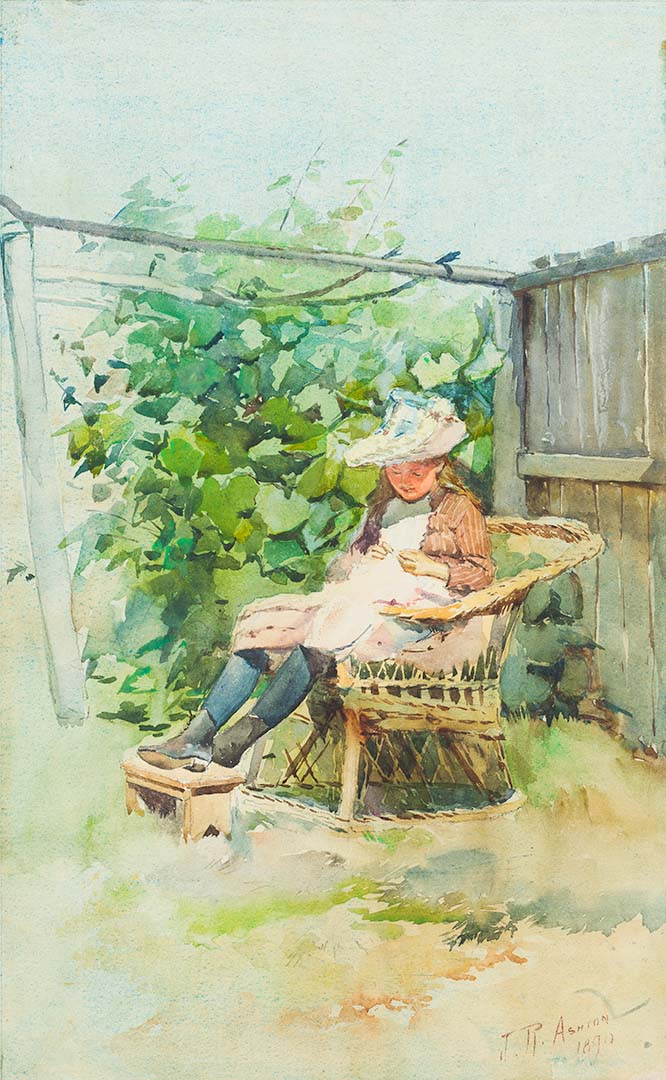
Julian Rossi Ashton / Australia 1851–1942 / (Young girl sewing in a garden) 1890 / Watercolour on paper / 43.4 x 26.5cm / Purchased 1989 from the estate of Lady Trout with a special allocation from the Queensland Government / Collection: Queensland Art Gallery | Gallery of Modern Art
Julian Rossi Ashton(Young girl sewing in a garden) 1890
Artwork
Julian Ashton’s choice of subject for this painting was interesting for several reasons. In the decades leading up to the date when (Young girl sewing in a garden) was produced, the most commonly favoured artists’ subjects were landscapes and history paintings (in which subjects from Australian social history, such as pioneering and gold mining, were idealised in order to supplement Australia’s apparent lack of ‘real history’). Although figures were often incorporated into these landscapes, they seldom formed the focus of a composition and were very rarely women or children, who were characteristically confined to interiors.
The identity of the model for (Young girl sewing in a garden) is not known. Ashton had a daughter, Bertha, however she would have been too young in 1890 to have been his model for this painting. In fact, the model was just as likely to have been a stranger, prevailed upon to pose for Ashton as she went about her work. Ashton recorded a similar incident in his biography: ‘I painted a watercolour of . . . [Clyde] street . . . and wishing to liven it up with a figure I asked a little girl who was skipping about if she would stand still for a few minutes . . .’1
Endnotes:
1. Ashton, Julian. ‘Now Came Still Evening On’. Angus & Robertson, Sydney, 1941, p.34.
Artist
Julian Rossi Ashton was born in Alderstone, England in 1851. He studied art in London at the West London School of Art, and in Paris at the Académie Julian, before emigrating to Australia in 1878 to work as an illustrator for newspapers in Melbourne and Sydney. Ashton painted landscapes, portraiture and figure groups in watercolours and oils.
He was among the first artists in Australia to adopt and teach plein air painting, soon becoming central to a group of artists experimenting with this technique including Frank P. Mahoney, A.H. Fullwood, A.J. Daplyn and Charles Conder, who painted around Sydney Harbour and in the region of the Hawkesbury River during the 1880s.
Ashton’s studies at the Académie Julian in Paris familiarised him with French impressionist painting techniques, particularly the practice of painting ‘en plein air’ (literally, ‘in open air’). While Louis Buvelot had already introduced plein air painting to Australia before Ashton’s arrival, it was Buvelot’s practice to merely execute detailed pencil sketches ‘en plein air’, later completing his canvases in the studio.

Louis Buvelot / Switzerland/Australia 1814–88 / The Wannon Falls 1868 / Oil on canvas / 76 x 102cm / Purchased 1973 / Collection: Queensland Art Gallery | Gallery of Modern Art
Louis BuvelotThe Wannon Falls 1868
Artwork
The Wannon Falls 1868 depicts a pastoral landscape with evidence of human habitation in the form of a small farmhouse, and sheep and cattle on the surrounding ridges. Located around 350 kilometres west of Melbourne, the falls were first explored by European settlers in 1836. By the 1860s, the falls had become a favoured destination for tourists from Melbourne. Scenic, yet potentially dangerous, waterfalls provided the quintessential tourist experience.
Louis Buvelot’s painting emphasises the day-to-day aspects of life, along with the colours, forms and qualities of light particular to the area. The work also reflects Buvelot’s changing attitude — he depicts the landscape in a naturalistic rather than a romantic manner, concentrating on those aspects of the landscape that he found distinctively Australian.
Artist
Born in Switzerland in 1814, Louis Buvelot studied art in Lausanne and Paris. After some years spent between Switzerland, Brazil and the East Indies, he migrated to Melbourne in 1865, aged 51.
On his arrival in Melbourne, Buvelot established a photographic studio in Bourke Street East with his companion, Caroline Julie Beguin. He abandoned the business after a year to focus on painting and proceeded to make his name as one of Australia’s foremost landscape artists.
Many artists in Australia in the mid nineteenth century were grappling with how best to portray local conditions. Buvelot’s work and his advocacy for the development of a uniquely Australian aesthetic influenced a younger generation of artists, including Tom Roberts and Frederick McCubbin who went on to form the Heidelberg School.
Discussion Questions
1. What is the first thing you see in the painting? Do you think the artist has composed the painting like this for a reason?
2. Research other artists who work using the plein air process. Consider how this is different to working from a photograph in a studio.
Activities
1. Consider how Buvelot has used light to draw us to the waterfall. Go for a walk around the school observing how light highlights certain spaces. Choose a location at school and take photographs at different times during the day. How do variations in natural light change the look and feel of the location?
2. Create an artwork that highlights a moving body of water such as a river, stream or ocean. Ensure the composition includes other features of the surrounding geographical location and signs of human life.
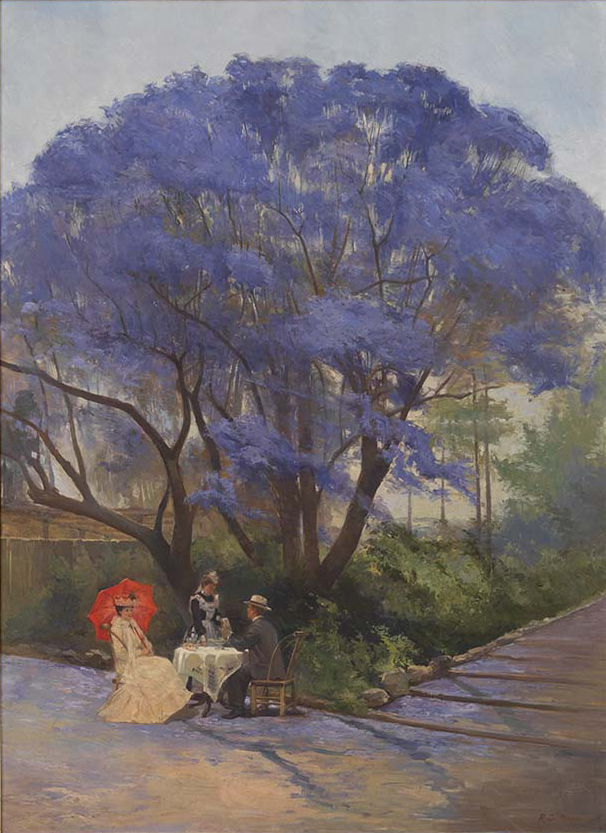
R. Godfrey Rivers / England/Australia 1859–1925 / Under the jacaranda 1903 / Oil on canvas / 143.4 x 107.2cm / Purchased 1903 / Collection: Queensland Art Gallery | Gallery of Modern Art
R. Godfrey RiversUnder the jacaranda 1903
Artwork
Completed 13 years after Godfrey Rivers arrived in Australia, Under the jacaranda 1903 offers a view of early twentieth-century life in Brisbane, with the subject reflecting a popular genteel European tradition of ‘taking tea’ in an attractive outdoor setting.
The work depicts the artist and his wife, Selina, under the shade of a jacaranda tree in full bloom in the Brisbane City Botanic Gardens. Rivers captures the majestic form of the tree, emphasising its distinctive colour with the contrasting green vegetation and the sparkling accent of the red umbrella. To the right of the foreground figures, the stone used as edging and in rockeries throughout the gardens can be seen. It is most likely composed of gneiss, a rock used as ballast on ships, and coral dredged from the nearby Brisbane River.
The jacaranda, planted by the Gardens’ Superintendent in 1864, is almost certainly the first one grown in Australia. Seeds of the native South American species were brought to Brisbane that same year, and by 1875 about 50 000 seeds and cuttings had been distributed in Queensland. Many of the jacarandas now growing in Brisbane suburbs are the progeny of this first tree.
Artist
Richard Godfrey Rivers was born in 1858 in Plymouth, England. He studied at the Slade School of Fine Art and exhibited at the Royal Academy before moving to Australia in 1889. Along with many painters of the Australian landscape who studied in Europe, Rivers needed to adapt his colour palette for Australia’s intense sunlight.
Rivers was Art Master at the Brisbane Technical College from 1891 to 1915, and during this time he made the adjoining City Botanic Gardens a popular outdoor painting and sketching location. His students included Bessie Gibson, Vida Lahey and Lloyd Rees.
An active member of the Queensland Art Society, he exhibited annually between 1891 and 1916, and was president of the society several times. A tireless advocate for the establishment of a public art gallery in Queensland, he was successful in persuading Premier Hugh Nelson to establish such an institution. The Queensland National Art Gallery opened in 1895, with Rivers serving as honorary secretary to the trustees. Shortly afterwards, he was appointed honorary curator. In 1915, Rivers moved to Tasmania where he died in 1925.
Discussion Questions
1. Look closely at the painting. How has the artist used colour and size to highlight certain objects? Can you explain how this painting might tell us a story from a long time ago?
2. Under the jacaranda captures a moment in time as viewed by a distant observer. How has Rivers positioned his viewers with a nostalgic perspective and in doing so, how has he established a sense of romanticism in the work?
Activities
1. Imagine you are a bird hovering above the scene in this painting. You are looking down on the tree and the people. Talk about what you can see. Draw the scene and add colour to your drawing. Compare yours and other students’ viewpoints.
2. Godfrey Rivers has used a triadic colour scheme to emphasise key features in his painting. The use of colours blue-violet, red-orange and green, draws attention to his wife Selina and the all-important jacaranda foliage. Find examples of similar colours in the landscape and document these in your journal through photography and drawing.
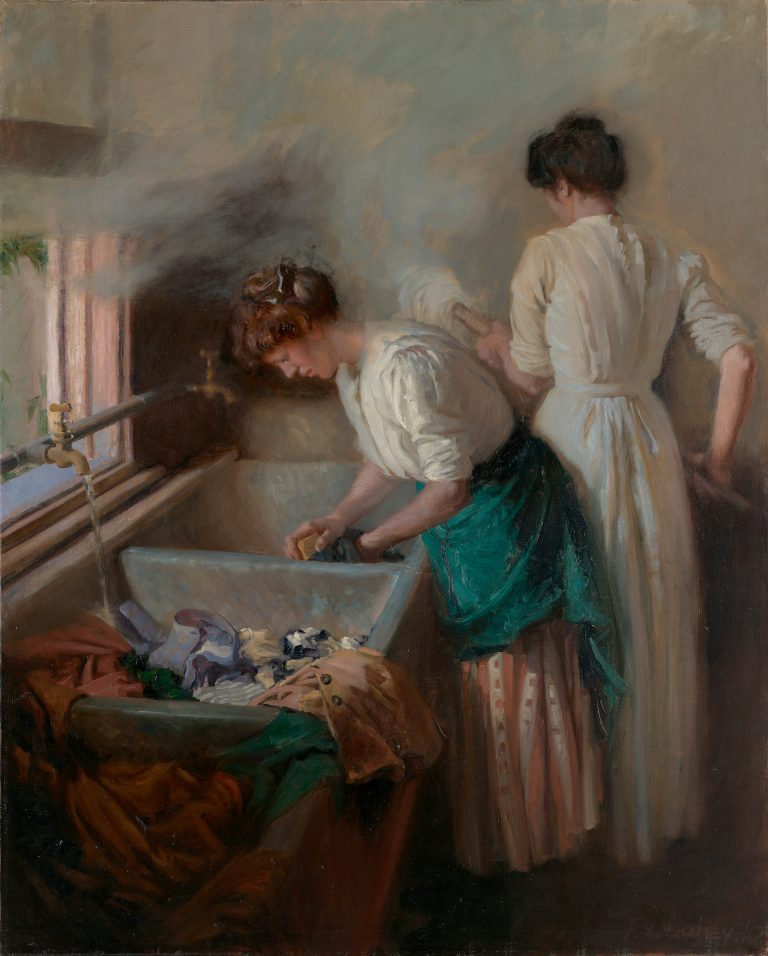
Vida Lahey / Australia 1882–1968 / Monday morning 1912 / Oil on canvas / 153 x 122.7cm / Gift of Madame Emily Coungeau through the Queensland Art Society 1912 / Collection: Queensland Art Gallery | Gallery of Modern Art / © QAGOMA
Vida LaheyMonday morning 1912
Artwork
Monday morning 1912 launched Vida Lahey’s career when it was exhibited at the annual exhibition of the Queensland Art Society, Brisbane, in 1912.
The painting shows in vivid colour and detail two women doing the weekly wash with copper tubs and bar soap at the Lahey family home, Greylands, in Indooroopilly, Brisbane. Esme, a younger sister of the artist, was the model for the woman at the washtub. The other woman is Flora Campbell, a family friend. The painting portrays ideas of femininity and feminism in a bygone era, when women’s lives were generally depicted in a more genteel fashion in Australian art and such hard labour went unacknowledged.
Monday morning follows the National Gallery of Victoria Art School tradition of the large narrative painting and, through its focus on atmospheric effects, shows the influence of Frederick McCubbin’s tutoring and his interest in Australian Impressionism. Students were encouraged to produce a large narrative painting to compete for the school’s triennial travelling art scholarship. This outstanding painting is Lahey’s only surviving large-scale work of the period.
Artist
Vida Lahey was born at Pimpama, near the Gold Coast, Queensland. Her first known paintings date from 1902. She studied at the National Gallery of Victoria Art School in Melbourne under Frederick McCubbin and Bernard Hall, and privately with Walter Withers. She also studied in Europe, but always returned to Brisbane where she lived and painted for most of her life.
Lahey was one of a new breed of artist — the trained professional who superseded the Victorian tradition of the genteel lady amateur. She exhibited more than 2000 paintings in about 200 exhibitions, many of them interstate and overseas.
Lahey advocated creative development as a priority in art education and was a pioneer of art education for children. Thousands of Queenslanders owe their art education to this dynamic woman, from her time teaching at the Brisbane High School for Girls (now Somerville House), her private tuition and classes at the Queensland Art Gallery, and her public lectures and broadcasts.
Discussion Questions
1. What does this painting tell us about the roles of women in Brisbane in the early 1900s? What does the title of the painting tell you?
2. What do you think the women would have seen outside their laundry window?
3. This painting depicts Vida Lahey’s sister and friend. Why is the work not classified as a portrait?